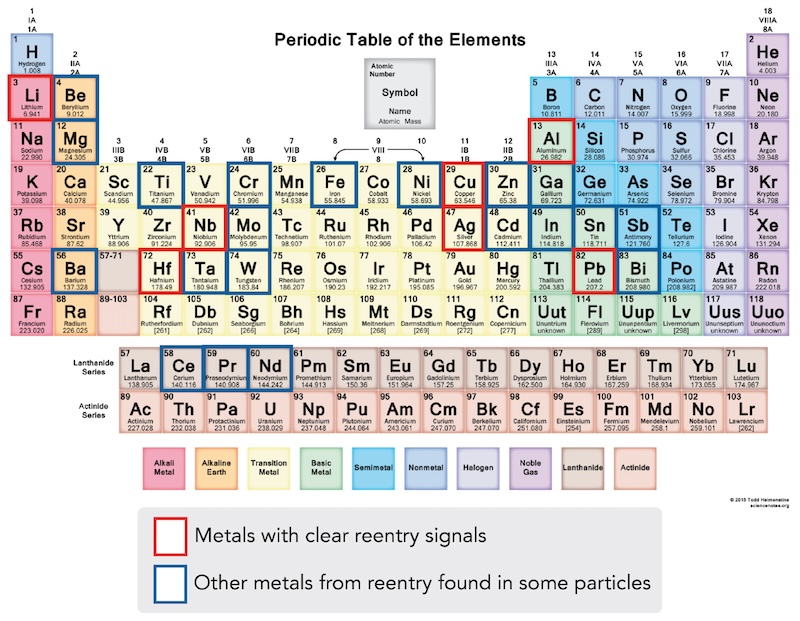
NOAA originally published this article on October 16, 2023. Edits by EarthSky.
Space vehicle reentries shed exotic metal particles
NOAA scientists investigating the stratosphere have found that in addition to meteoric space dust, Earth’s atmosphere more than 7 miles (11 km) above the surface contains an unexpected quantity of particles with a variety of exotic metals. The scientists believe the particles come from satellites and spent rocket boosters as they are vaporized by the intense heat of reentry.
These metals in our atmosphere are linked to rockets and satellites vaporizing in our atmosphere such as this Starlink satellite disintegrating over Puerto Rico in February 2022.
#Space: video shows #Starlink satellite #disintegrating over #PuertoRico after #GeomagneticStorm
? https://t.co/F77QvSF1GF via @Gizmodo pic.twitter.com/CwQioD8wvG— Maxime Duprez (@maximaxoo) February 11, 2022
The 2024 lunar calendars are here! Best Christmas gifts in the universe! Check ’em out here.
NOAA used a high-altitude plane to collect data
The discovery is one of the initial findings from analysis of data collected by a high-altitude research plane over the Arctic during a NOAA Chemical Science Laboratory mission called Stratospheric Aerosol processes, Budget and Radiative Effects (SABRE). It’s one of the agency’s studies to investigate aerosol particles in the stratosphere, a layer of the atmosphere that moderates Earth’s climate and is home to the protective ozone layer.
Using a sensitive instrument custom-built at NOAA in Boulder, Colorado, and mounted in the nose of a NASA WB-57 research aircraft, scientists found aluminum and exotic metals embedded in about 10% of sulfuric acid particles, which comprise the large majority of particles in the stratosphere. They were also able to match the ratio of rare elements they measured to special alloys used in rockets and satellites. Thus, they confirmed that their source was metal vaporized from spacecraft reentering Earth’s atmosphere.
The findings were published October 16, 2023, in the Proceedings of the National Academy of Sciences.

The mission found exotic particles
Chemical Sciences Laboratory research chemist Daniel Murphy, who led a team including scientists from CIRES, Purdue and the University of Leeds, said:
Two of the most surprising elements we saw in these particles were niobium and hafnium. These are both rare elements that are not expected in the stratosphere. It was a mystery as to where these metals are coming from and how they’re ending up there.
The SABRE mission focused on aerosols, tiny particles that absorb and reflect the sun’s rays, shielding the Earth. And under the right conditions, they serve as surfaces for ozone-destroying chemical reactions. So this discovery by NOAA scientists represents the first time that stratospheric pollution has been linked to reentry of space debris.
Niobium and hafnium do not occur as free elements in nature, but are refined from mineral ores. Semiconductors and superalloys use them.
In addition to these two unusual elements, a significant number of particles contained copper, lithium and aluminum at concentrations far exceeding the abundance found in space dust.
According to Murphy:
The combination of aluminum and copper, plus niobium and hafnium, which are used in heat-resistant, high-performance alloys, pointed us to the aerospace industry.

How they identified the metal particles
NOAA scientists were able to precisely identify so many different metals thanks to a custom-built instrument called Particle Analysis by Laser Spectrometry (PALMS). It ingests and chemically analyzes individual particles in the air one by one as the aircraft is in flight. On the WB-57, they installed PALMS into the nose cone of the aircraft with a large forward-facing air intake inlet.
After entering the inlet, an aerosol particle passes through two detecting laser beams that measure its size and speed. Then they trigger a third high-powered laser to vaporize the particle. Finally, they sweep the electrically charged remnants into two identical mass spectrometers, one for positive ions and one for negative ions. The spectrometers determine the exact atomic mass and relative abundance of each element in the particle, generating a chemical “fingerprint” for each particle.
Pressing questions that need answers
Of course, scientists are eager to understand how these particles of aerospace debris interact with other aerosols in the stratosphere, especially because of the anticipated increase in space traffic and their potential impact on the ozone layer. They also want to explore the impact of possible future proposals to seed the stratosphere with millions of tons of sulfur aerosols to slow the rate of global warming by reflecting sunlight back to space.
Murphy and his co-authors estimate that 10% of stratospheric sulfuric acid particles currently contains traces of metals from rockets and satellites. However, they say that could grow to 50% or more based on the current number of satellites launched into low-earth orbit. Also, there are efforts to eliminate space debris at end-of-life by directing it into the atmosphere to burn up. So according to researchers, these particles could change our planet’s atmosphere in ways we still don’t fully understand.
Murphy indicated:
There will be a lot of work to understand the implications of these novel metals in the stratosphere.
By the way, as of October 4, the tracking website Orbiting Now lists 8,697 satellites currently in orbit, 7,892 of which are in low-Earth orbit and are destined to burn up on reentry.
Co-author Martin Ross of The Aerospace Corporation said:
At 10%, the current fraction of stratospheric aerosol with metal cores is not large. But over 5,000 satellites have been launched in the past five years. Most of them will come back in the next five, and we need to know how that might further affect stratospheric aerosols.
Bottom line: Studies made of the stratosphere by NOAA identified metal particles linked to rockets and satellites vaporized in our atmosphere upon reentry.
Source: Metals from spacecraft reentry in stratospheric aerosol particles











